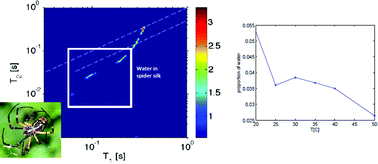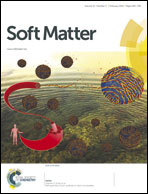Inverse temperature transition of elastin like motifs in major ampullate dragline silk: MD simulations of short peptides and NMR studies of water dynamics
Abstract
Using deuterium 2D T1 − T2 Inverse Laplace Transform (ILT) NMR, we have investigated the distribution, population, and dynamics of waters of hydration in major ampullate N. clavipes and A. aurantia silk as a function of temperature. In both samples studied, correlation times much larger than that of free water are measured, and in some cases, appear to increase with increasing temperature over the range of 5 to 60 °C (corresponding to reduced tumbling). In addition, the experimental data point to a reduction in the population of water localized in the silk with increasing temperature in the range of 20 to 50 °C. Molecular dynamics simulations were performed to probe the thermal characteristics of a variety of repeating motifs found in the two silk samples. The repeating motifs GLGSQ, GAAAAAAG, GPGGY, GPGQQ, GPSG, and GPSGPGS found in N. clavipes, GLGSQ, GYGSG, GPGSG, and GPGSQ found in A. aurantia silk were found to exhibit a thermal property observed in short elastin peptides known as the “inverse temperature transition”. This is a well known characteristic exhibited by short peptides consisting of (VPGXG)n motifs (where X is any amino acid other than proline) found in elastin – a protein responsible for the elasticity of vertebrate tissues. In qualitative agreement with experimental measurements of water in the silks, all the peptides studied in simulation show evidence of an increase in sidechain contacts and peptide hydrogen bonds, concomitant with a decrease in radius of gyration and localized water as the temperature is raised from approximately 5 to 60 °C.

- This article is part of the themed collection: Silk and silk-inspired materials

 Please wait while we load your content...
Please wait while we load your content...